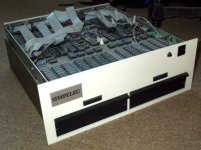ArchaicAmusements
Member
I recently got an Altos ACS8000 with "Simpelec" branding. It has dual SA800 (one is a SA801 configured as an 800) floppy drives and the Altos 8200 motherboard (with DMA controller). I've been playing around with it over the weekend and I've got it booting to the monitor (v2.01). The monitor merely states "ALTOS COMPUTER SYSTEMS, Monitor ROM v2.01, Insert disk in drive 0 for autoload". Now I've checked all the PSU rails and everything is spot on, the machine has a full 208K of ram (or so I gather) and has all 3 SI0 chips so other than the FPP (optional) it's "maxed out". When it boots, Drive 0's activity led goes red constantly (empty drive) and it just sits there (no further console out) is this to be expected? (I'm sure the cables are ok - it reminds me of when you wire a floppy drive cable upside down  ). Basically I would like some disks for this system (physical or images). The system is badged on the back as an 8000-7E but I also have the delivery receipt that says 8000-6 and also 8000-5+HD controller so I don't know what model it actually is. The SA800 drives appear to both be SSDD but I have no way to test them for now. I've looked around on the internet but I can only find images for later models (the -14). Any information would be great and disk wise anything that will run on it would be greatly appreciated. I've never used a machine with 8" drives before and I'm wondering if I can write my DSDD (Imation/3M - if it matters) media in these SSDD drives? I should also say this is a 230v 50Hz system and I don't know anything about its history. Thanks for your time.
). Basically I would like some disks for this system (physical or images). The system is badged on the back as an 8000-7E but I also have the delivery receipt that says 8000-6 and also 8000-5+HD controller so I don't know what model it actually is. The SA800 drives appear to both be SSDD but I have no way to test them for now. I've looked around on the internet but I can only find images for later models (the -14). Any information would be great and disk wise anything that will run on it would be greatly appreciated. I've never used a machine with 8" drives before and I'm wondering if I can write my DSDD (Imation/3M - if it matters) media in these SSDD drives? I should also say this is a 230v 50Hz system and I don't know anything about its history. Thanks for your time.

